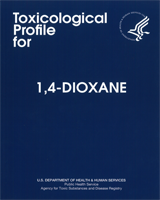NCBI Bookshelf. A service of the National Library of Medicine, National Institutes of Health.
Excerpt
This public health statement tells you about 1,4-dioxane and the effects of exposure to it.
The Environmental Protection Agency (EPA) identifies the most serious hazardous waste sites in the nation. These sites are then placed on the National Priorities List (NPL) and are targeted for long-term federal clean-up activities. 1,4-Dioxane has been found in at least 31 of the 1,689 current or former NPL sites. Although the total number of NPL sites evaluated for this substance is not known, the possibility exists that the number of sites at which 1,4-dioxane is found may increase in the future as more sites are evaluated. This information is important because these sites may be sources of exposure, and exposure to this substance may be harmful.
When a substance is released either from a large area, such as an industrial plant, or from a container, such as a drum or bottle, it enters the environment. Such a release does not always lead to exposure. You can be exposed to a substance only when you come in contact with it. You may be exposed by breathing, eating, or drinking the substance, or by skin contact.
If you are exposed to 1,4-dioxane, many factors will determine whether you will be harmed. These factors include how much (the dose), how long (the duration), and how you come in contact with it. You must also consider any other chemicals you are exposed to and your age, sex, diet, family traits, lifestyle, and state of health.
Contents
- FOREWORD
- QUICK REFERENCE FOR HEALTH CARE PROVIDERS
- PEER REVIEW
- 1. PUBLIC HEALTH STATEMENT
- 1.1 WHAT IS 1,4-DIOXANE?
- 1.2 WHAT HAPPENS TO 1,4-DIOXANE WHEN IT ENTERS THE ENVIRONMENT?
- 1.3 HOW MIGHT I BE EXPOSED TO 1,4-DIOXANE?
- 1.4 HOW CAN 1,4-DIOXANE ENTER AND LEAVE MY BODY?
- 1.5 HOW CAN 1,4-DIOXANE AFFECT MY HEALTH?
- 1.6 HOW CAN 1,4-DIOXANE AFFECT CHILDREN?
- 1.7 HOW CAN FAMILIES REDUCE THEIR EXPOSURE TO 1,4-DIOXANE?
- 1.8 IS THERE A MEDICAL TEST TO DETERMINE WHETHER I HAVE BEEN EXPOSED TO 1,4-DIOXANE?
- 1.9 WHAT RECOMMENDATIONS HAS THE FEDERAL GOVERNMENT MADE TO PROTECT HUMAN HEALTH?
- 1.10 WHERE CAN I GET MORE INFORMATION?
- 2. RELEVANCE TO PUBLIC HEALTH
- 3. HEALTH EFFECTS
- 3.1 INTRODUCTION
- 3.2 DISCUSSION OF HEALTH EFFECTS BY ROUTE OF EXPOSURE
- 3.3 GENOTOXICITY
- 3.4 TOXICOKINETICS
- 3.5 MECHANISMS OF ACTION
- 3.6 TOXICITIES MEDIATED THROUGH THE NEUROENDOCRINE AXIS
- 3.7 CHILDREN’S SUSCEPTIBILITY
- 3.8 BIOMARKERS OF EXPOSURE AND EFFECT
- 3.9 INTERACTIONS WITH OTHER CHEMICALS
- 3.10 POPULATIONS THAT ARE UNUSUALLY SUSCEPTIBLE
- 3.11 METHODS FOR REDUCING TOXIC EFFECTS
- 3.12 ADEQUACY OF THE DATABASE
- 4. CHEMICAL AND PHYSICAL INFORMATION
- 5. PRODUCTION, IMPORT/EXPORT, USE, AND DISPOSAL
- 6. POTENTIAL FOR HUMAN EXPOSURE
- 7. ANALYTICAL METHODS
- 8. REGULATIONS, ADVISORIES, AND GUIDELINES
- REFERENCES
- GLOSSARY
- APPENDIX A ATSDR MINIMAL RISK LEVELS AND WORKSHEETS
- APPENDIX B USER'S GUIDE
- APPENDIX C ACRONYMS, ABBREVIATIONS, AND SYMBOLS
- APPENDIX D HEALTH ADVISORY
UPDATE STATEMENT: A Toxicological Profile for 1,4-Dioxane, Draft for Public Comment was released in October 2007. This edition supersedes any previously released draft or final profile.
Toxicological profiles are revised and republished as necessary. For information regarding the update status of previously released profiles, contact ATSDR at: Agency for Toxic Substances and Disease Registry, Division of Toxicology and Environmental Medicine/Applied Toxicology Branch, 1600 Clifton Road NE, Mailstop F-62, Atlanta, Georgia 30333
THE PROFILE HAS UNDERGONE THE FOLLOWING ATSDR INTERNAL REVIEWS: 1. Health Effects Review. The Health Effects Review Committee examines the health effects chapter of each profile for consistency and accuracy in interpreting health effects and classifying end points. 2. Minimal Risk Level Review. The Minimal Risk Level Workgroup considers issues relevant to substance-specific Minimal Risk Levels (MRLs), reviews the health effects database of each profile, and makes recommendations for derivation of MRLs. 3. Data Needs Review. The Applied Toxicology Branch reviews data needs sections to assure consistency across profiles and adherence to instructions in the Guidance. 4. Green Border Review. Green Border review assures the consistency with ATSDR policy.
DISCLAIMER: Use of trade names is for identification only and does not imply endorsement by the Agency for Toxic Substances and Disease Registry, the Public Health Service, or the U.S. Department of Health and Human Services.
- NLM CatalogRelated NLM Catalog Entries
- Review Toxicological Profile for Cadmium[ 2012]Review Toxicological Profile for CadmiumFaroon O, Ashizawa A, Wright S, Tucker P, Jenkins K, Ingerman L, Rudisill C. 2012 Sep
- Review Toxicological Profile for Lead[ 2007]Review Toxicological Profile for LeadAbadin H, Ashizawa A, Stevens YW, Llados F, Diamond G, Sage G, Citra M, Quinones A, Bosch SJ, Swarts SG. 2007 Aug
- Review Toxicological Profile for RDX[ 2012]Review Toxicological Profile for RDXAbadin H, Smith C, Ingerman L, Llados FT, Barber LE, Plewak D, Diamond GL. 2012 Jan
- Review Toxicological Profile for Manganese[ 2012]Review Toxicological Profile for ManganeseWilliams M, Todd GD, Roney N, Crawford J, Coles C, McClure PR, Garey JD, Zaccaria K, Citra M. 2012 Sep
- Review Toxicological Profile for Chromium[ 2012]Review Toxicological Profile for ChromiumWilbur S, Abadin H, Fay M, Yu D, Tencza B, Ingerman L, Klotzbach J, James S. 2012 Sep
- Toxicological Profile for 1,4-DioxaneToxicological Profile for 1,4-Dioxane
Your browsing activity is empty.
Activity recording is turned off.
See more...
